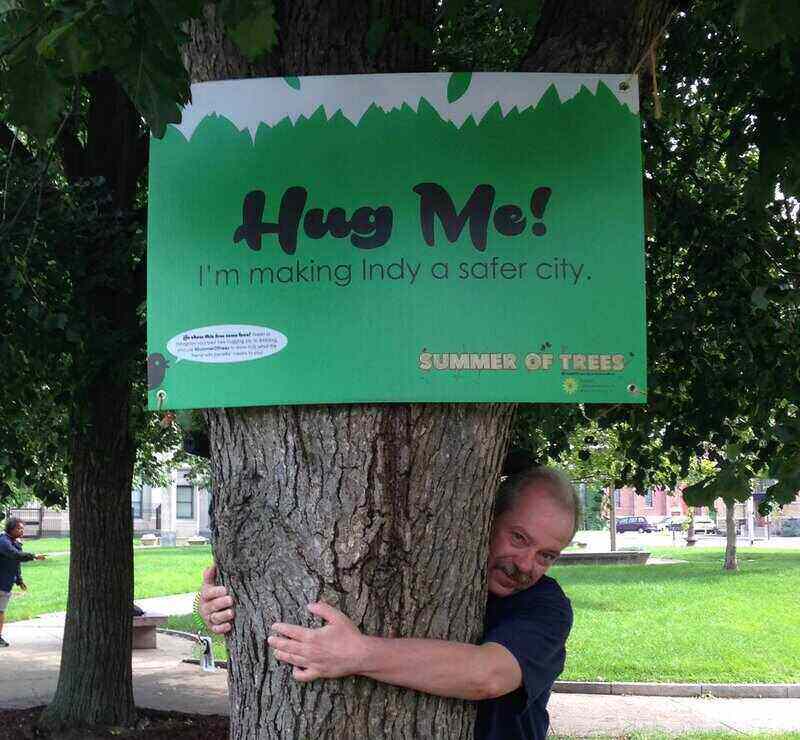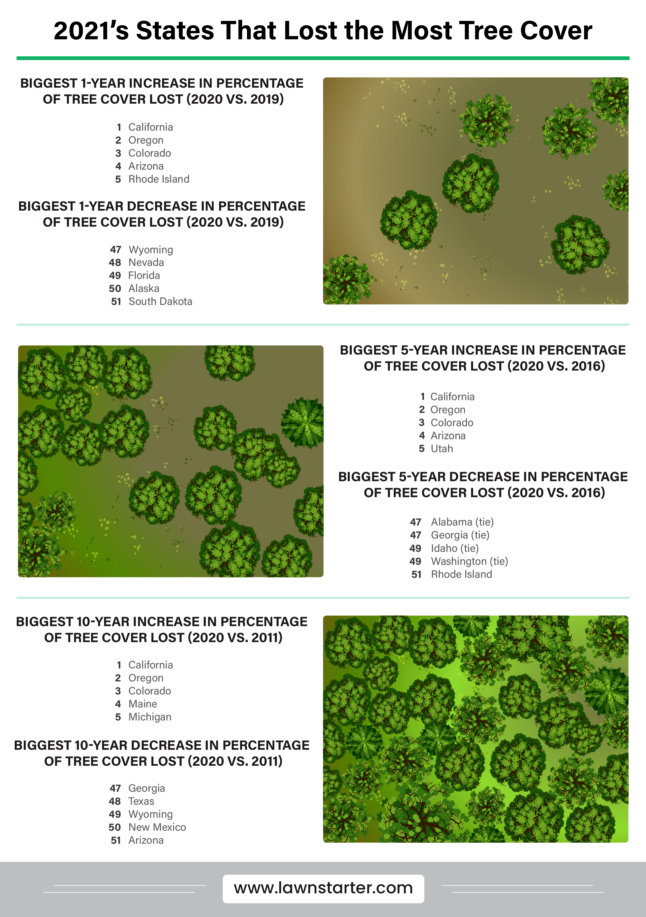
Trees are one of Mother Nature’s greatest gifts. Beyond providing shade and curb appeal, trees produce oxygen, trap climate-changing carbon, and prevent floods.
That’s why it’s always painful to lose even a single tree — let alone entire swaths of them, known as “tree cover” or “tree canopy.” Unfortunately, some states are losing more of these green giants — and losing them faster — than others.
LawnStarter compared the 50 states and the District of Columbia across eight key metrics over four time periods to determine where tree cover has shrunk the most over the years. Specifically, we looked at the latest annual rate of loss, as well as 1-, 5-, and 10-year comparisons.
Check out our ranking below, followed by some highlights, lowlights, and insights from a panel of experts, and hug a tree on Love a Tree Day, May 16.
Table of Contents
State Rankings
See how each state and the District of Columbia fared in our ranking:
| OVERALL RANK | State | Overall Score | 1-Year Loss Rank | 1-Year Loss Difference Rank | 5-Year Loss Difference Rank | 10-Year Loss Difference Rank |
|---|---|---|---|---|---|---|
| 1 | California | 100 | 1 | 1 | 1 | 1 |
| 2 | Oregon | 63.81 | 2 | 2 | 2 | 2 |
| 3 | Colorado | 45.55 | 11 | 3 | 3 | 3 |
| 4 | South Carolina | 38.09 | 4 | 36 | 41 | 12 |
| 5 | Maine | 37.07 | 13 | 10 | 19 | 5 |
| 6 | Mississippi | 34.91 | 6 | 39 | 43 | 40 |
| 7 | Louisiana | 34.57 | 7 | 14 | 35 | 45 |
| 8 | North Carolina | 33.22 | 8 | 40 | 44 | 38 |
| 9 | Wisconsin | 33.12 | 21 | 20 | 6 | 7 |
| 10 | Michigan | 33.09 | 19 | 23 | 7 | 6 |
| 11 | Alabama | 32.68 | 5 | 45 | 48 | 46 |
| 12 | Arizona | 32.41 | 16 | 4 | 4 | 51 |
| 13 | Virginia | 32.2 | 17 | 33 | 39 | 24 |
| 14 | Georgia | 31.98 | 3 | 46 | 47 | 48 |
| 15 | Utah | 31.6 | 20 | 42 | 5 | 43 |
| 16 | Texas | 30.97 | 12 | 7 | 37 | 49 |
| 17 | Alaska | 30.9 | 9 | 50 | 46 | 4 |
| 18 | Florida | 30.33 | 10 | 49 | 40 | 42 |
| 19 | Minnesota | 30.23 | 22 | 35 | 25 | 34 |
| 20 | New Hampshire | 30.13 | 24 | 31 | 28 | 9 |
| 21 | Arkansas | 29.59 | 14 | 44 | 45 | 44 |
| 22 | Massachusetts | 29.34 | 30 | 11 | 18 | 13 |
| 23 | Tennessee | 29.3 | 23 | 26 | 32 | 37 |
| 24 | Maryland | 29.27 | 32 | 9 | 17 | 16 |
| 25 | Iowa | 29.23 | 41 | 6 | 8 | 18 |
| 26 | West Virginia | 28.98 | 29 | 29 | 29 | 14 |
| 27 | Delaware | 28.88 | 27 | 38 | 31 | 11 |
| 28 | Missouri | 28.71 | 31 | 12 | 21 | 33 |
| 29 | New York | 28.57 | 40 | 22 | 10 | 21 |
| 30 | Pennsylvania | 28.57 | 36 | 26 | 9 | 32 |
| 31 | Vermont | 28.53 | 42 | 21 | 13 | 20 |
| 32 | Washington | 28.5 | 15 | 43 | 50 | 8 |
| 33 | Ohio | 28.19 | 38 | 8 | 26 | 28 |
| 34 | New Jersey | 28.17 | 39 | 41 | 14 | 17 |
| 35 | Connecticut | 27.98 | 44 | 19 | 22 | 22 |
| 36 | Kansas | 27.96 | 46 | 13 | 16 | 25 |
| 37 | Illinois | 27.88 | 48 | 15 | 15 | 27 |
| 38 | North Dakota | 27.81 | 50 | 18 | 11 | 31 |
| 39 | Indiana | 27.76 | 47 | 16 | 20 | 26 |
| 40 | Nevada | 27.66 | 35 | 47 | 11 | 15 |
| 41 | District of Columbia | 27.52 | 51 | 24 | 23 | 29 |
| 42 | Hawaii | 27.37 | 45 | 30 | 30 | 23 |
| 43 | Oklahoma | 27.32 | 25 | 37 | 36 | 41 |
| 44 | Nebraska | 27.25 | 49 | 28 | 27 | 30 |
| 45 | Kentucky | 27.24 | 37 | 17 | 34 | 35 |
| 46 | Montana | 27.05 | 26 | 32 | 42 | 36 |
| 47 | Idaho | 26.32 | 18 | 34 | 49 | 19 |
| 48 | New Mexico | 24.4 | 43 | 25 | 24 | 50 |
| 49 | Wyoming | 23.02 | 33 | 48 | 38 | 47 |
| 50 | Rhode Island | 22.68 | 34 | 5 | 51 | 10 |
| 51 | South Dakota | 19.23 | 28 | 51 | 33 | 39 |

Highlights and Lowlights
California Burning
California not only ranked No. 1 overall among the States That Lost the Most Tree Cover, but it also swept every single metric.
In 2020 alone, the Golden State saw its worst wildfire season ever, destroying some of its oldest green giants: redwoods, sequoias, and Joshua trees. California wildfires ravaged over 4 million acres — an area bigger than Connecticut — accounting for 40% of the total acres burned across the U.S.
California has lost more tree canopy than any other state in every time period we logged, mostly due to wildfires but also to droughts and pests.
The Wild(fire) West
Climbing to the other top spots in our ranking — after California — are Oregon at No. 2 and Colorado at No. 3. These states also regularly experience, and are among the most vulnerable to, wildfires, which is why this problem bears mentioning a second time.
Of the 10.1 million acres destroyed by wildfires in 2020 — nearly half are federally protected forest land — 9.5 million acres were in Western states, including our top three. Each of these states recorded some of the worst wildfires in their history last year.
A striking pattern for these states: With the exception of Colorado’s No. 11 position for tree-cover loss in 2020, each claimed the same spot in every category as its overall position.
Bordering on the Coast
Except for Utah, all of the states in our top 20 are along the U.S. coast or the Canadian and Mexican borders. They include, for example, Maine at No. 5, Michigan at No. 10, Arizona at No. 12, and Texas in 16th place.
What explains this peculiar theme? Some of these states are among the most heavily forested in the country, for one. Plus, coastal states are twice as developed as the rest of the U.S., meaning greater harvesting. Clearly, societal growth comes at a tall price.
Great Plains, Great for Trees
The bottom 10 states in our ranking — meaning the states with minimal deforestation over time — are dominated by the Great Plains, claiming half of these spots. They include Oklahoma at No. 43, Montana at No. 46, and South Dakota in last place.
(The other half of the bottom 10 are all over the map, including Hawaii at No. 42, New Mexico at No. 48, and Rhode Island at No. 50.)
Why? The name of this region says it all: The Great Plains landscape is the least forested in the country and mostly flat, covered in prairie and grassland. A semi-arid climate simply prohibits tree growth. In these states, “I got lost in the woods” is never a valid excuse.
Ask The Experts
Everyone has a part to play in saving America’s trees. But what can we each contribute? We asked a panel of tree experts to weigh in. See what they had to say below.
- Deforestation sped up globally during the pandemic, resulting in the release of over 2.5 billion metric tons of carbon dioxide into the atmosphere. In the U.S. specifically, what interventions are needed now to prevent further deforestation and consequent carbon emission?
- The 2020 U.S. wildfire season, which burned over 10.1 million acres, has been the second worst on record in terms of acres impacted in a year. What three measures should be implemented now to prevent a worse wildfire season in 2021?
- Where are the best places for individuals to plant trees to help the environment?
- What are the three best ways to care — and show some love — for trees?
- What are the best alternatives to cutting down trees to create products that traditionally rely on wood, such as paper?
- What are the top five benefits of tree cover/canopy to a state’s well-being?




1. Deforestation sped up globally during the pandemic, resulting in the release of over 2.5 billion metric tons of carbon dioxide into the atmosphere. In the U.S. specifically, what interventions are needed now to prevent further deforestation and consequent carbon emission?
The U.S. does not have the same problem with deforestation as countries with tropical forests that have never been cleared in the past. By far most forest products in the U.S. come from areas planted in trees for the purpose of harvesting trees rather than coming from primary or natural forests in their ecologically historic state, so there is not necessarily a net loss in forested area over time.
There is some such continued loss of natural forests in the U.S., but the level was low in 2020 relative to the previous last several years.
2. The 2020 U.S. wildfire season, which burned over 10.1 million acres, has been the second worst on record in terms of acres impacted in a year. What three measures should be implemented now to prevent a worse wildfire season in 2021?
There is probably not much that can be done at this point to prevent a worse wildfire season in 2021, except to continue to educate the public in how to make their homes more defensible against wildfire and to improve systems for evacuating people to prevent loss of life.
In the longer term, there needs to be more prescribed fire and wildfire management to let areas burn under acceptable conditions to reduce fuel loads. However, given how far the fuel beds have changed from historic conditions, combined with the effects of climate change, the effects of such fire today are not always as ecologically beneficial as we would like and sometimes result in novel ecosystems. Even so, they are effective in reducing fuel loads and facilitating management of subsequent wildfires.
3. Where are the best places for individuals to plant trees to help the environment?
Anywhere that the tree species is in its natural range of conditions. Planting trees native to the area both improves natural habitat and increases the chances that the tree will thrive.
4. What are the three best ways to care — and show some love — for trees?
- Provide their historic natural conditions, whether it be burning or mowing to simulate burning if the tree was in a fire-maintained community, or reducing competition with other trees if the tree was in an open-canopy forest.
- Provide the best hydrological conditions for that tree.
- Soil compaction from vehicles is generally to be avoided.
5. What are the best alternatives to cutting down trees to create products that traditionally rely on wood, such as paper?
It is hard to think of a better alternative, as wood and other plant products are the only ecologically sustainable and carbon-neutral sources of material used for paper, building materials, etc.
6. What are the top five benefits of tree cover/canopy to a state’s well-being?
Canopy cover is not automatically beneficial (for example, if it is higher than historic conditions and thus limits light to herbaceous plants on which wildlife depend and increases evapotranspiration and loss of groundwater).
However, where appropriate, tree canopy cover is important for wildlife habitat, decreasing urban temperatures by providing shade, and releasing heat from incident solar radiation through transpiration that otherwise might be absorbed by solid surfaces, providing more mesic environments by increasing local relative humidity, providing oxygen, and aesthetics.

1. Deforestation sped up globally during the pandemic, resulting in the release of over 2.5 billion metric tons of carbon dioxide into the atmosphere. In the U.S. specifically, what interventions are needed now to prevent further deforestation and consequent carbon emission?
Deforestation is not an issue in North America. The number of acres of forest land in the U.S. has been stable since about 1910. Sustainable forest management responsibly supplies us with a plentiful wood supply now and into the future.
However, American consumers may contribute to deforestation in other countries by consuming their wood products. To combat deforestation, consumers must select foreign wood that is certified by a third party like SFI or FSC. These third parties certify that wood is sourced responsibly.
2. The 2020 U.S. wildfire season, which burned over 10.1 million acres, has been the second worst on record in terms of acres impacted in a year. What three measures should be implemented now to prevent a worse wildfire season in 2021?
Standing dead trees, particularly due to a severe and prolonged outbreak in pine beetles in our western forests, need to be salvaged and used for durable wood products. A prime example of this is the emerging markets in mass timber. Tall buildings are now being constructed almost entirely out of wood, potentially storing that carbon for hundreds of years.
So, to prevent wildfires, prevent the buildup of fuels by:
- Salvaging beetle-killed trees.
- Promoting the development of new markets for innovative and value-added wood products, such as mass timber that can store carbon for long periods.
- Improving proactive forest management measures to make the forests resilient to climate change-related disturbance, such as beetles and wildfires.
3. Where are the best places for individuals to plant trees to help the environment?
Always remember to plant the right tree in the right place.
4. What are the three best ways to care — and show some love — for trees?
- Understand that sustainable forest management (or just forestry in the U.S.) and deforestation are diametrically opposed.
- Respect the forest.
- Appreciate what trees give us before and after harvest.
5. What are the best alternatives to cutting down trees to create products that traditionally rely on wood, such as paper?
The more we rely upon wood to replace carbon-intensive materials like concrete, steel and plastic, the better!
Wood is a renewable, carbon-negative material unlike any other. It’s critical to appreciate that the more we use wood, the more forest we will have, not the opposite. Deforestation happens when the forest land has less value than other uses, like agriculture or shopping malls.
Always remember that a forest provides us with clean air, clean water, places to recreate, and materials for a myriad of uses — name an open pit mine or corn field that can compete with that!

Deforestation sped up globally during the pandemic, resulting in the release of over 2.5 billion metric tons of carbon dioxide into the atmosphere. In the U.S. specifically, what interventions are needed now to prevent further deforestation and consequent carbon emission?
There were some unfortunate examples of deforestation, especially in Brazil, where the government has decided that protecting forests is no longer in Brazil’s best interest. Hopefully, the international community and Brazilian citizens can reverse this decision and encourage Brazil to take more interest in protecting their forest assets.
Some deforestation may be warranted in a place like Africa to feed a growing population there. But happily, deforestation since 1980 has been curbed across the world’s forests so that forests are once again growing. For the last several decades, forest growth has exceeded deforestation so that forests are storing ever more carbon every year.
The 2020 U.S. wildfire season, which burned over 10.1 million acres, has been the second worst on record in terms of acres impacted in a year. What three measures should be implemented now to prevent a worse wildfire season in 2021?
The cause of the fires in 2020 include a regional drought in the West. There is little that can be done about droughts in arid places like the American West.
However, the fires were also exacerbated by a long-run policy of fire suppression, which has built up unusually large flammable material in forests. This can be dealt with by a combination of clearing fire breaks around roads, thinning forests, and controlled burns.
The final measure that can be taken by private citizens who live in forests is to clear the land close to valuable buildings. This will make it easier for firefighters to protect those buildings and reduce the damage from fires.
Where are the best places for individuals to plant trees to help the environment?
A great deal of land that is suitable for forests is owned by private individuals in relatively small plots. By maintaining forests in these suburban and semi-rural areas, private citizens can maintain forest habitat that would otherwise be subdivided.
What are the three best ways to care — and show some love — for trees?
Plant and care for a tree that is special to you.
What are the best alternatives to cutting down trees to create products that traditionally rely on wood, such as paper?
Although cutting down trees for forest products and paper sounds destructive, the forest industry has been a renewable industry since about 1990. Every tree that is cut down is replanted in the modern market.
The demand for timber products gives the market an incentive to keep land in forests. As the demand for forest products declines, the supply of forests will shrink in the long run.
What are the top five benefits of tree cover/canopy to a state’s well-being?
There are economic benefits to forests that lead to income, jobs, and valuable natural resources. But there are also important nonmarket benefits to forests that include habitat, recreation, soil protection, and carbon storage. Depending on the state, the size of these benefits vary a great deal so that some states get a lot of economic benefit from forests, whereas others primarily get nonmarket benefits.
Methodology
We ranked the 50 U.S. states and the District of Columbia from biggest loss (No. 1) to smallest loss (No. 51) of tree cover based on their overall scores. A state’s or the District’s overall score (out of 100 possible points) is the average of all of its weighted scores across the metrics listed below.
“Tree cover” (or “tree canopy”) is defined by Global Forest Watch as “all vegetation greater than 5 meters in height, and may take the form of natural forests or plantations across a range of canopy densities.”
“Tree cover loss,” meanwhile, “may be the result of human activities, including forestry practices such as timber harvesting or deforestation (the conversion of natural forest to other land uses), as well as natural causes such as disease or storm damage.”
In the table below, “annual deforestation” is measured in thousands of hectares (kha).
Please note that “X-year difference” is calculated as the difference in annual absolute or percentage losses between two specific years only, not as a cumulative loss spanning the entire period between those two years.
For example, Alaska lost 172 kha of tree cover in 2020 and 248 kha in 2016. To obtain the 5-year difference in tree cover loss by thousands of hectares (2020 vs. 2016), we subtracted 172 kha from 248 kha, the difference being -76 kha. We did not calculate the difference in losses for every year between 2016 and 2020.
| Metrics | Weighting | Min. Value | Max. Value |
|---|---|---|---|
| 1-Year Loss | |||
| Tree Cover Loss in Thousands of Hectares (2020) | 2 | 0 kha | 322 kha |
| Percentage of Tree Cover Lost (2020) | 3 | 0.10% | 3.30% |
| 1-Year Loss Difference | |||
| 1-Year Difference in Tree Cover Loss in Thousands of Hectares (2020 vs. 2019) | 1 | -264 kha | 196 kha |
| 1-Year Difference in Percentage of Tree Cover Lost (2020 vs. 2019) | 2 | -2.68% | 2.00% |
| 5-Year Loss Difference | |||
| 5-Year Difference in Tree Cover Loss in Thousands of Hectares (2020 vs. 2016) | 1 | -76.8 kha | 159 kha |
| 5-Year Difference in Percentage of Tree Cover Lost (2020 vs. 2016) | 2 | -1.45% | 1.60% |
| 10-Year Loss Difference | |||
| 10-Year Difference in Tree Cover Loss in Thousands of Hectares (2020 vs. 2011) | 1 | -59.5 kha | 289.2 kha |
| 10-Year Difference in Percentage of Tree Cover Lost (2020 vs. 2011) | 2 | -1.70% | 2.97% |
Source: Global Forest Watch
Why This Study Matters
The world is losing trees — fast. And it’s no better here at home: Between 2009 and 2014, U.S. cities and rural communities collectively lost 36 million trees per year.
To put that in perspective, 36 million trees would save Americans $96 million annually by lowering our energy bills, cleaning the air, and capturing harmful carbon that contributes to climate change.
Those are just a few of the benefits we get from tree cover — and that’s just in urban and rural areas. Everywhere in America, trees stabilize our soil, bear fruit, and shelter our wildlife. They supply the materials for our homes, buildings, and the products we use.
Plus, trees are a great escape and a source of relaxation. Step into the woods, and you’ll find your heart rate and blood pressure dropping instantly. In short, trees are vital to our health and survival.
Tree cover loss worsened during the pandemic: Deforestation accelerated, and the wildfire season was the second most devastating on record. Only three times since the 1960s have more than 10 million acres of trees been burned in a single year, and they all occurred in the last six years, including 2020.
Experts predict that this year’s wildfire season stands to be even worse unless we do more to protect our trees.
So, hug a neighborhood green giant on Love a Tree Day — it’s literally saving your life.
Main Photo Caption: LawnStarter’s Editor-in-Chief, Jeff Herman, hugs a tree in Downtown Indianapolis in 2015.